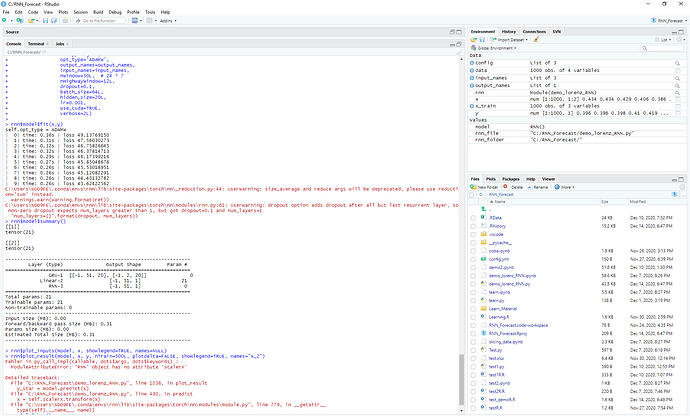Hi I'm currently want to integrate a python module in R. basically I want to call the main command in R, but all Classes and Function are written in python. I'm using reticulate in R and when I'm calling a function plot_result in my RNN class it shows an error that there is no attribute 'scalerX' in RNN
when I run the python code with the exact same commands it works just fine.
Here are my codes in R and python: you can see the error message in attachment.
Please help me with this issues, I reallyneed it for my thesis.
rnn <- import("demo_lorenz_RNN", as = NULL, convert = TRUE, delay_load = FALSE)
rnn$plt$style$use('seaborn')
data <- rnn$getLorenzData(1000L,200L,"np",TRUE)
data <- as.data.frame(data)
x_train <- data[1:3]
x <- x_train[1:2]
y <- x_train[3]
x <- data.matrix(x[1:2])
y <- data.matrix(y[1])
input_names <- list('x_0', 'x_1', 'x_2')
output_names <- list('x_2')
model <- rnn$RNN(epochs=100L,
nHorizon=0L,
RNNType="gru", # "lstm"
opt_type='ADAMW',
output_names=output_names,
input_names=input_names,
nWindow=50L, # 24 * 7
nHighwayWindow=12L,
dropout=0.1,
batch_size=64L,
hidden_size=20L,
lr=0.001,
use_cuda=TRUE,
verbose=2L,
ScalerTypeX="StandardScaler"
rnn$model$fit(x,y)
rnn$model$summary()
rnn$plot_inputs(model, x, showlegend=TRUE, names=NULL)
rnn$plot_result(model, x, y, nTrain=500L, plotdelta=FALSE, showlegend=TRUE, names=list("x_2"))
rnn$plt$show()
here are only snippet codes in python I hope you could still understand it: Note that def predict(), def fit() , and def fit_ADAMW() are in the function in RNN class, but def plot_result are outside the RNN class
through the code rnn$model$fit(x,y), the variable "scalerX", should already be defined(MinMaxScaler or StandardScaler) as you can see in the def fit_ADAMW()
but somehow the R couldn't read the variable "scalerX", or maybe r cant save the variable which already be defined before. That's why in "rnn$plot_result()" shows an error.
def plot_result(model, x, y, nTrain, plotdelta=True, showlegend=True, names=None):
plt.figure()
N = x.shape[0]
nTrain = min(N, nTrain)
print(f'nTrain = {nTrain}')
target_all = y
y_star = model.predict(x)
...
...
def predict(self, x):
N = x.shape[0]
#print(f'RNN predict N = {N}')
ret = np.empty((N, 1))
ret[:] = np.nan
x = self.scalerX.transform(x)
x_star = torch.from_numpy(x).type(self.dtype).to(self.device)
#print(f'x_star.shape = {x_star.shape}')
# bc=N, nWindow, dim
input_x = x_star.view(1, x_star.shape[0], x_star.shape[1])
#print(f'input_x.shape = {input_x.shape}')
idy = range(self.nHorizon, x.shape[0]) # -self.nHorizon)
#print(f'RNN predict idy = {idy}')
y_star = self.forward(input_x)
#print(f'RNN 1 y_star.shape = {y_star.shape}')
y_star = y_star.view(1, -1)
#print(f'RNN 2 y_star.shape = {y_star.shape}')
y_star = y_star.data.cpu().numpy().transpose()
#print(f'RNN 3 y_star.shape = {y_star.shape}')
y_star = self.scalerY.inverse_transform(y_star)
if self.nHorizon > 0:
y_star = y_star[:-self.nHorizon]
#print(f'RNN 3 y_star.shape = {y_star.shape}')
ret[idy, :] = y_star
#print(f'RNN predict y_star.shape = {y_star.shape}')
return ret
...
...
def fit(self, x, y):
print(f'self.opt_type = {self.opt_type}')
if self.opt_type == 'ADAMW':
self.fit_ADAMW(x, y)
elif self.opt_type == 'GPMINIMIZE':
self.fit_GPMINIMIZE(X, Y)
elif self.opt_type == 'LSQ':
self.fit_LSQ(x, y)
else:
raise NotImplementedError()
def fit_ADAMW(self, x, y):
self.input_size = x.shape[1]
if self.LossType == 'L1':
self.criterion = torch.nn.L1Loss(size_average=False)
elif self.LossType == 'MSE':
self.criterion = torch.nn.MSELoss(size_average=False)
if self.use_cuda:
self.cuda()
self.criterion.cuda()
else:
self.cpu()
self.input_size = x.shape[1]
self.P = TSDataHandler(nWindow=self.nWindow,
nHorizon=self.nHorizon,
nSeq=self.nWindow)
#print(f'nWindow={self.nWindow}, nHorizon={self.nHorizon}, nSeq={self.nWindow}')
if self.ScalerTypeX == 'StandardScaler':
self.scalerX = StandardScaler().fit(x)
elif self.ScalerTypeX == 'MinMaxScaler':
self.scalerX = MinMaxScaler().fit(x)
